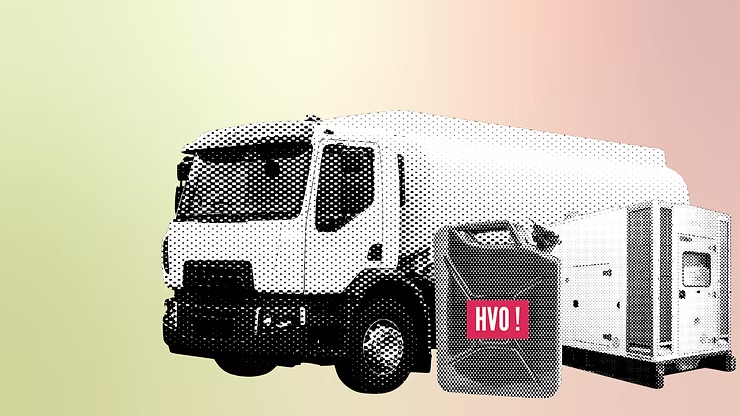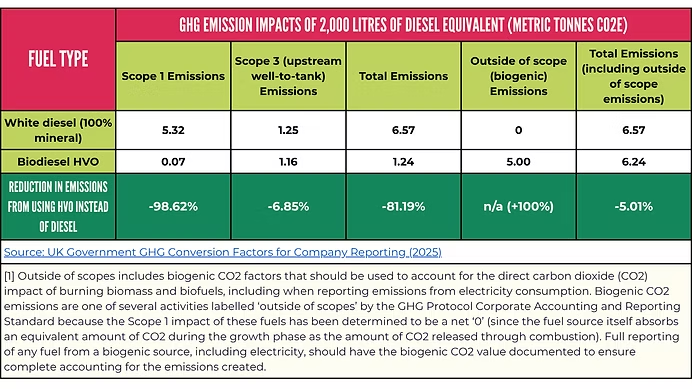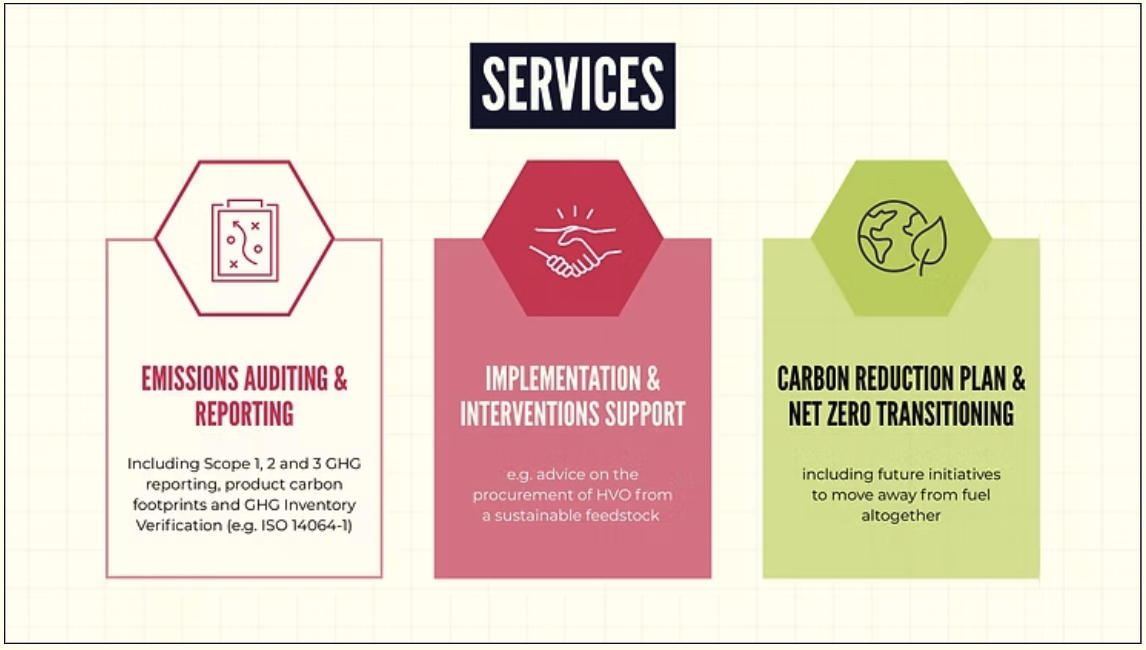
HVO Fuel Explained: And It's Role Within The Events And Entertainment Industry

Powering events and entertainment is often complex. To cut environmental and carbon impacts, we always recommend starting with the fundamentals: use energy more efficiently, prioritise renewables, connect to the grid where possible, and use batteries or hybrid systems to manage peaks. We’ll cover how to specify a full low‑carbon setup in a future post.

However, where grid connection and renewable energy aren’t available and liquid fuels have to be used in generators, a good alternative to diesel is HVO, as it is a fossil-oil free fuel. HVO fuel is widely used across the events and entertainment sector as a way to help reduce emissions and improve sustainability credentials. But what is HVO, what are the pros and cons of using it and how effective is it in the transition to net zero?
This article unpacks how HVO is currently used within the industry and shares our perspective on the transitional role it should play in the wider move toward truly renewable energy. Switching generators from fossil-diesel to HVO (hydrotreated vegetable oil) is a practical first step many organisers can take now. We’ll outline common misconceptions and key considerations - including compatibility, credible sourcing, sustainability claims, cost, and operations - to ensure HVO is used responsibly as part of a genuine transition to cleaner power, while recognising that it is not the final solution.
What is HVO fuel?
Hydrotreated Vegetable Oil (HVO) is a 2nd generation biofuel primarily produced from a mix of organic waste products, such as recycled waste fats and oils (commonly rapeseed, sunflower or palm oil; waste cooking oil; or animal fats) and in some cases post-consumer waste such as plastics.
Within the UK, the BS EN 1940 specification ensures that HVO, unlike traditional FAME biodiesel, has similar properties to fossil diesel and can be used as a drop in alternative is existing diesel engines.
How is HVO made?
Where is HVO being used?
HVO is a direct replacement for diesel. It’s widely adopted across the events and entertainment industry, powering generators, plant and machinery. It is also used in logistics, transportation and construction.
What are the benefits and drawbacks of using HVO?
Benefits
GHG Emissions: HVO has lower GHG emissions per Litre of fuel
One of the biggest selling points for HVO is that it produces fewer greenhouse gas (GHG) emissions across its lifecycle when compared to fossil fuel alternatives, whether that’s 100% mineral white diesel, average biofuel blend diesel or red diesel being used.
The table below compares the GHG impacts, showing that:
- Based on the UK Gov DESNZ emissions factors, the direct emissions at the point of energy generation (Scope 1 emissions) are about 99% lower*.
- However, making HVO is not impact-free. The process creates byproducts like carbon dioxide. When you take into account these upstream “well-to-tank” impacts, the overall emission savings from HVO are closer to 81% compared to diesel.
- It is very important to note that these figures also excludes what are called ‘outside of scope’ impacts, such as biogenic impacts, that aren’t included within your measured footprint (see the UK Government definition in the table below). With these impacts included, GHG emissions from HVO are only 5% lower compared to diesel.
*Although actual emissions tests on exhausts have found there to only be around 5-10% lower CO2 and slightly lower NOx than regular diesel.
This takes into account that more HVO fuel will be required as a replacement for diesel as it has a lower energy density. If you burned 2,000 litres of diesel, you’d need at least 3% more HVO fuel to get the same power output, explained in one of our disadvantages.

Air quality & particulate matter: HVO has cleaner 'tailpipe' emissions than fossil-fuel based alternatives
Across its lifecycle, HVO is a cleaner source of fuel and creates fewer harmful pollutants than burning diesel or other fossil fuels (e.g. particulate matter, nitrogen oxides, carbon monoxide and other hydrocarbon byproducts). These pollutants all contribute to poor local air quality, impacting the environment/biodiversity and human health (particularly in relation to respiratory issues). This is true regardless of the specific HVO feedstock that you purchase, but some sources of HVO are certainly 'cleaner' than others, especially when considering the full supply chain-related impacts (see feedstock/supply chain point below). It's also not considered toxic if it spills as it's biodegradable, so it poses less ecological risk.
Fuel properties: HVO is actually a more stable fuel and has better cold weather performance
HVO can be used as a direct replacement for diesel as it is compatible with diesel engines without any modification; this is what makes it such an 'easy win' for many who use it. On top of this, it also has a few advantageous properties over alternatives. It is a more stable fuel, which creates other key benefits:
- HVO has a longer storage/shelf life than biodiesel alternatives due to a reduced risk of degradation as a result of water and microbial contamination
- It can prolong the life of engines and reduce maintenance costs by generating less waste and impurities
- It performs better at lower temperatures, where diesel without additives can wax and form a gel that can't be burned efficiently/can clog filters.
- HVO is biodegradable and nontoxic, minimising the ecological risk from spills.
Drawbacks
Feedstock/Supply Chain: Not all HVO is sustainable or the same; it depends on the feedstock and supply chain!
HVO is produced from renewable (e.g. biomass) or waste product feedstock, reducing the reliance on fossil fuels and finite resources and is a more 'circular' source of fuel than diesel.
However, not all HVO is the same, the different feedstocks used to create HVO and the integrity of that feedstock's supply chain can impact the sustainability of that type of HVO. For example, HVO that is made from virgin palm oil or other mass produced crops that are associated with similar supply chain challenges, would not be considered as sustainable as HVO from certified waste oils or residue-based crops. This is due to the nature of mass production, which drives mass deforestation and biodiversity loss, human rights conflicts and an increased risk of microbial contamination, diseases and pests.
To help avoid this, you can ask fuel suppliers for transparency on where their HVO comes from. There are also verification schemes that help to prove the source and quality of HVO:
- ISCC or RED II Verification: ensures some level of traceability and sustainability of the fuelstock, derived from waste or residences and not virgin palm oil.
- EN 15940 standard: aims to ensure the fuel quality and safety as a direct replacement for diesel.
- ZEMO Partnership Renewable Fuels Assurance Scheme aims to verify supplier claims focusing on the traceability of feedstocks.
Cost and energy density: HVO has a higher cost and lower energy density compared to fossil-fuel based alternatives
This one probably goes without saying, but HVO is still currently more expensive per litre than diesel. It also has a slightly lower energy density (around 3% less per litre at a minimum, so at least 3% more fuel will be used to create the same power output). This highlights the need for efficient power planning to enable reductions in fuel consumption.
Supply/logistics: Limited availability and possible supply issues of HVO
Although there is a growing supply of HVO in the UK, it's still not as widely available as diesel and can be harder to procure, especially in times of high demand, as some of our summer festival clients have experienced in the past. This limited availability may mean that the fuel has to travel further to get to you (but the impact of this is all generally included in the 'upstream well-to-tank' emission impacts!).
The Bottom Line
HVO can be a quick win for reducing emissions in reporting terms - if only certain parts of its lifecycle are included - without needing to change equipment. Utilising HVO is a step in the right direction, but it’s not the end goal. It does not replace the need to improve energy efficiency through power management, or the need to move away from fuel and towards infrastructure that is both renewable and zero-carbon at the point of generation.
Using HVO should only be seen as a stepping stone whilst simultaneously working on increased energy efficiency and transitioning towards renewable infrastructure like solar or wind and the use of mains power.
Our Approach
We help our clients to make informed decisions on sustainable fuels. We only recommend using HVO where there is no other alternative and only if there is traceable feedstock and ethical suppliers. HVO should be seen as a short-term transition as part of a wider journey towards net zero, followed by further action to phase out the use of fuel based energy completely.
We can help you to measure the impact of switching to HVO, or support you on your transition to more sustainable and renewable energy sources through our services below:



.png)

